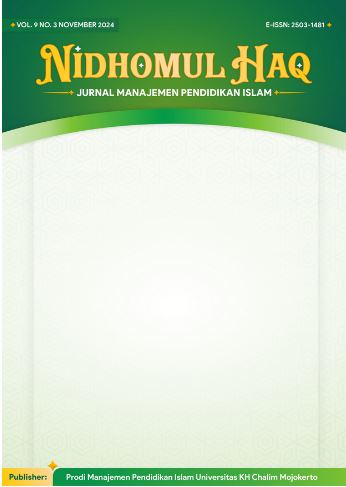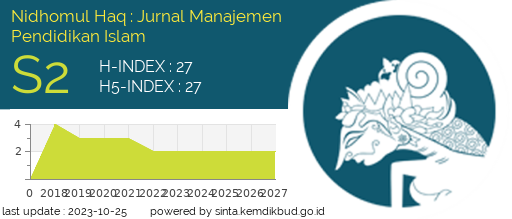Implementation Of Prophetic Communication Of The Head Of Man Medan City (Multi-Site Study In MAN Medan)
DOI:
https://doi.org/10.31538/ndhq.v10i2.183Keywords:
Implementation, Prophetic Communication, Principal of Madrasah, Multisite StudyAbstract
This study aims to: 1) Analyze the prophetic communication method of the Madrasah Principal at MAN Kota Medan; 2) Analyze the role of the Madrasah Principal in implementing prophetic communication; 3) Identify supporting and inhibiting factors; and 4) Understand the prophetic communication model applied. The approach used is qualitative with a case study type and multi-site design. A qualitative approach with a multi-site case study method is used to deeply understand the application of the communication model. Data were collected through observation, in-depth interviews, and documentation studies, and analyzed using a cross-site analysis approach. The results of the study indicate that the Madrasah Principal at MAN Kota Medan applies prophetic communication based on exemplary behavior, compassion, wisdom, and empathy. Although all madrasahs refer to the principles of communication of the Prophet Muhammad SAW, each has its own uniqueness in its implementation. The role of the madrasah principal is identified as a communicative, solution-oriented, and spiritual role model, and contributes to the formation of an Islamic and harmonious madrasah culture. Supporting and inhibiting factors for prophetic communication were found to be related to leadership, madrasah culture, and HR competency. Each madrasah shows its uniqueness: MAN 1 excels in the culture of deliberation and religious programs, MAN 2 in interpersonal relationships and teacher competence, and MAN 3 in the adaptation of technology based on prophetic values. The prophetic communication model applied includes the principles of Qaulan Sadidan, Qaulan Balighan, Qaulan Maisuran, Qaulan Layyinan, Qaulan Kariman, and Qaulan Ma'rufan. This model creates a harmonious, supportive, and productive madrasah environment, while creating a learning atmosphere that is conducive to students' academic and spiritual development.
References
Ahwan, Z., & Karfida, P. D. (2025). The Role of Parental Communication in Cultivating Children’s Mental Resilience with Islamic Values to Overcome Bullying. Communicator: Journal of Communication, 2(1), Article 1. https://doi.org/10.59373/comm.v2i1.48
Anggraeni, Muhaemin, I. S. (2025). Prophetic Leadership in Islamic Schools: Transforming Teacher Performance and Student Achievement. INTERNATIONAL JOURNAL OF ASIAN EDUCATION, 6(1), 17–28.
Arif, M. (2021). Prophetic Leadership in Forming the Religious Moderation Values in Islamic Education Institutions. Cendekia: Jurnal Kependidikan Dan Kemasyarakatan, 19(2), 219–235. https://doi.org/10.21154/cendekia.v19i2.3109
Arifin, M., & Kartiko, A. (2022). Strategi Pendidikan Agama Islam Berbasis Multikultural Di Madrasah Bertaraf Internasional. Attadrib: Jurnal Pendidikan Guru Madrasah Ibtidaiyah, 5(2), 194–202. https://doi.org/10.54069/attadrib.v5i2.396
Baihaqy, S. A., & Ramli, A. (2023). Pola Komunikasi Dalam Manajemen Sekolah Dan Madrasah. Tolis Ilmiah: Jurnal Penelitian, 5(2), 120. https://doi.org/10.56630/jti.v5i2.456
Bastomi, H. (2017). Pendidikan Karakter dalam Pembentukan Akhlak Anak Pra Sekolah. Jurnal Elementary, 5(1), 80–91.
Cangara, H. (2009). Pengantar Ilmu Komunikasi. Raja Grapindo Persada.
Caropeboka, R. M. (2017). Konsep Dan Aplikasi Ilmu Komunikasi. Andi Offset.
Desy Ariani, W. K. (2022). Fungsi Dan Kegunaan Filsafat Manajemen Pendidikan. Jurnal Penelitian CARE, 1(7), 1–12.
Ghazali, Z. I. (2023). Prophetic Leadership in Islamic Educational Institutions in the 4.0 Era. Al-Abshar: Journal of Islamic Education Management, 2(1), 26–48. https://doi.org/10.58223/al-abshar.v2i1.61
Hamzah, A. (2020). Metode Penelitian Studi Kasus: Single Case, Instrumental Case, Multicase dan Multisite. Literasi Nusantara Abadi.
Hasanah, M., Arafat, Y., Barni, M., Raya, A. T., & Aprilianto, A. (2024). Teachers’ Strategies for Managing Disruptive Behavior in The Classroom During The Learning Process. Nazhruna: Jurnal Pendidikan Islam, 7(3), Article 3. https://doi.org/10.31538/nzh.v7i3.7
Hasiara, L. O. (2017). Penelitian Multi Kasus dan Multisitus. CV IDRH.
Hefner, R. W. (2007). Introduction; The culture, politics and of muslim educations. Princenton University Press.
Indonesia, K. A. R. (2020). Keputusan Menteri Agama Republik Indonesia.
Irawan, G. B., & Radiamoda, A. (2023). Prophetic Communication: Implementation of Da’i Da’wah Strategies in The Millennial Era. Ishlah: Jurnal Ilmu Ushuluddin, Adab Dan Dakwah, 5(2), 249–261. https://doi.org/10.32939/ishlah.v5i2.260
Islamy, I. El. (2020). Publik Dalam Pemberdayaan Masyarakat Islam. In Tesis.
Jamaluddin, H. (2020). Komunikasi Profetik Islam (Nilai dan Etika Komunikasi Persfektif Islam). Al-Ubudiyah Jurnal Pendidikan Dan Studi Islam, 1(2), 39–43.
Jhon W Creswell. (2010). Research Design: Pendekatan Kualitatif, Kuantitatif dan Mixed. In Research Desigh Qualitative, Quantitative, and Mixed Methods Approaches (p. 411). Pustaka Belajar.
Kartiko, A., Rokhman, M., Priyono, A. A., & Susanto, S. (2024). Peningkatan Kinerja Guru Melalui Budaya Organisasi dan Kepemimpinan Servant Kepala Madrasah. Urwatul Wutsqo: Jurnal Studi Kependidikan Dan Keislaman, 13(1), Article 1. https://doi.org/10.54437/urwatulwutsqo.v13i1.1323
Kompasiana. (2023). Maraknya Kasus Narkoba di Lingkungan Pelajar Konten ini telah tayang di Kompasiana.com dengan judul ‘Maraknya Kasus Narkoba di Lingkungan Pelajar’, Klik untuk baca: Https://www.kompasiana.com/edidya70766/655a3152edff76663a0bcaf2/maraknya-kasus-narkoba-di-.
Kuntowijoyo. (2006). Islam Sebagai Ilmu: Epistemologi, Metodologi, dan Etika. Tiara Wacana.
Matthew B. Miles, A. Michael Huberman, J. S. (2014). Qualitative Data Analysis: A Methods Sourcebook. SAGE Publications.
Munawwarah, R., & Darlis, A. (2025). The Implementation of Prophetic Education in Shaping Students’ Islamic Character: A Phenomenological Study at MAS Plus Al-Ulum. Asatiza : Jurnal Pendidikan, 6(1), 77–87.
Munir, M. M., & Suryadi, A. (2022). The Implementation of Al-Qiy adah Al Nabawiyah on the Institution of Islamic Education ( Study on Smait Al Fityan School Medan ). Scienta : Social Sciences & Humanities, 1(2), 339–347. https://doi.org/10.51773/icobba.v1i2.99
Murni, M., & Adiyono, A. (2024). Prophetic Leadership: A Review of Its Role in Improving Islamic Education Institutions in Indonesia. International Journal of Teaching and Learning (INJOTEL), 2(1), 179–196.
Najmuddin, M., Amri, M., & Aderus, A. (2022). Prophetic Communication: Islam as Knowledge Practice. Palakka : Media and Islamic Communication, 3(2), 98–111. https://doi.org/10.30863/palakka.v3i2.3742
Ni’matussa’adah. (2021). Komunikasi Profetik Pada Santri Putri Tahfiz Di Pondok Pesantren Al-Hidayah Karang suci Purwokerto. IAIN Purwokerto.
Ning Widhi, M. A.-Z., Masruroh, I., & Achmad, K. (2023). Penerapan Komunikasi Profetik dalam Dakwah Inklusif di Pesantren Waria Al-Fattah Yogyakarta. Jurnal Edutrained : Jurnal Pendidikan Dan Pelatihan, 7(2), 128–144. https://doi.org/10.37730/edutrained.v7i2.233
Nurdin, A. (2013). Pengantar llmu Komunikasi. Mitra Media Nusantara.
Rafidah, M. (2021). Perspektif Islamphobia Pasca Tragedi 11 September 2001. Local History & Heritage, 1(1), 15–20.
Rahman, T., Indriati, A., & Ridwan, M. K. (2024). Prophetic Communication in Historical and Axiological Review. KOMUNIKA: Jurnal Dakwah Dan Komunikasi, 18(1), 59–69. https://doi.org/10.24090/komunika.v18i1.7976
Retno Manuhoro Setyowati, Errika Dwi Setya Watie, A. S. (2020). Representation of Disability Achievements in Television Talk Show Programs. Jurnal The Messenger, 12(1), 40–53.
Robbins, S. P., & Judge, T. A. (2019). Organizational behavior. Pearson Education.
Syahputra, I. (2007). Komunikasi Profetik Konsep dan Pendekatan. Simbiosa Rekatama Media.
Tanjung, F. H., & Akbar, A. (2023). Prophetic Communication of Islamic and Christian Religious Leaders in Overcoming Conflict of Religious Harmony (Social Studies at Griya 1, Martubung Village, Medan City). Jhss (Journal of Humanities and Social Studies), 7(1), 139–143. https://doi.org/10.33751/jhss.v7i1.7487
Tasbih, & Hafid, S. A. (2023). The Importance of Prophetic Communication Principles (A Critical Study of the Hadith of Communication). Al-Ulum, 23(2), 442–461. https://doi.org/10.30603/au.v23i2.3315
Wijayanti, A. (2015). Strategi guru pendidikan agama Islam dalam meningkatkan kesadaran keagamaan pada siswa di SMAN 1 Pandaan Kabupaten Pasuruan.
Zubaedi. (2013). Desain Pendidikan Karakter: Konsepsi Dan Aplikasinya Dalam Lembaga Pendidikan. Grup Media Kencana Prenanda.
Downloads
Published
How to Cite
Issue
Section
License
Copyright (c) 2025 Umi Kalsum, Mesiono, Achyar Zein

This work is licensed under a Creative Commons Attribution-ShareAlike 4.0 International License.






